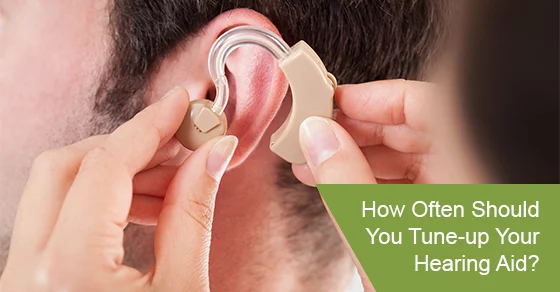How Often Should You Tune-up Your Hearing Aid?
Posted by Living Sounds

How well do you use and take care of your hearing aids? Like any device, hearing aids require regular maintenance to check their condition and ensure that they can support your hearing needs for years. No matter what type of hearing aid you use, its best performance and long-term function is only as good as its regular maintenance.
Regular hearing aid maintenance includes a check-up that allows hearing aid practitioners to assess the devices’ performance. It helps your hearing healthcare provider better support your lifestyle needs with a properly fitting hearing aid so you can continue enjoying the benefits of your hearing aid.
When was the last time you booked a tune-up for your hearing aids? Whether you’re a seasoned hearing aid user or you’re just adjusting to its regular use, learn how often your hearing aids require maintenance to optimize your listening experience:
Hearing Aid Tune-Up: Annual Maintenance
At a minimum, hearing aids require maintenance at least once a year. An annual tune-up will check and reprogram your hearing aid to suit your evolving hearing needs if necessary. It’s essential to compensate for declining hearing or the progression of your hearing loss so that you can cope better in occupational and social settings. Don’t wait for your hearing to deteriorate so much that your hearing aid won’t respond to shifts in your hearing and requires replacement.
For best results, you should book hearing aids maintenance at least every six months. Your audiologist can track changes in your hearing and adjust the hearing aid settings accordingly. This helps prevent gaps in ineffective listening and communication, which is the exact purpose of properly functioning hearing aids.
When to Change Hearing Aid Batteries
Are your hearing aids working correctly? If not, it’s not automatically a sign of damage. More often than not, the batteries just ran out, and you need to replace them. This is essential maintenance that you can do at home.
To get in the habit of changing your hearing aid batteries for uninterrupted listening, familiarize yourself with the colour-coded legend for different battery types. Each type of hearing aid typically requires a specific battery size, which is much easier to remember by colour. If this is your first time changing hearing aid batteries, open the battery door and look inside to see what type of batteries you need to get.
You will also know when it’s time for fresh batteries when your hearing aids start beeping, or they function at reduced power. Don’t ignore these signs to avoid disruptions to effective listening and communications. Leaving old and expired batteries inside and unchanged may cause corrosion, so don’t prolong the battery change to maintain the optimal lifespan of your hearing aid.
Alternatively, there are now wireless and rechargeable hearing aids that eliminate the need for regular battery changes. Just like your other devices, these need to be charged daily, depending on your use. Once fully charged, these hearing aids provide up to 24 hours of full listening, making them low-maintenance and easy to use, just like any smart device.
Daily Maintenance: Clean Your Hearing Aids
A crucial part of hearing aid maintenance — but one that’s often overlooked — is daily cleaning. Yes, hearing aids need to be cleaned regularly because of earwax and other residues. Because most hearing aids either sit inside the ear or have tubings that go into the ear canal, it’s common for earwax to build up and muffle sound transmitted into your ear. That reduces the effectiveness and benefits of hearing aids, which should be compensating for the impact of hearing loss.
To prevent this, make sure to clean your hearing aids every day. Use a gentle cloth to wipe them down and remove debris. If your hearing aid has a dome, you can remove it and clean the inside with a brush. Ask your hearing aid provider to replace the built-in wax guard during the annual maintenance service to ensure adequate protection against earwax build-up and muffled hearing.
Once you’ve finished cleaning your hearing aids, make sure to dry them thoroughly before putting their parts back together. Any trapped moisture in the interior can cause hearing aids to malfunction and shorten their lifespan.
Use a specially designed air blower, or store your hearing aids in a drying box or pouch overnight for a thorough clean and drying using UV light or a silica gel cap to absorb remaining moisture. For best results, avoid getting your hearing aids wet, but if you do, never use a hairdryer, heater, or microwave to prevent distortion of the plastic parts.
Upgrade to New Hearing Aid Technology
Hearing aids are rapidly evolving to help people with hearing loss cope better and maintain quality of life. Even in the last five years alone, hearing aids have come a long way in terms of specialized features like environment detection and sound optimization, noise cancellation, and device streaming, as well as wireless and rechargeable capabilities, smaller, discreet sizes, and increased processing speeds.
You may be reluctant to part with well-loved hearing aids. Let your clinician demonstrate how these benefits will better support your listening and communication needs. You can discover these new features during routine hearing aid maintenance or book a full evaluation and learn about the value of upgrading to a new and improved hearing device.
To learn more about hearing aid maintenance and how often you should tune them up, call Living Sounds at 855-628-5153, or contact us here.

